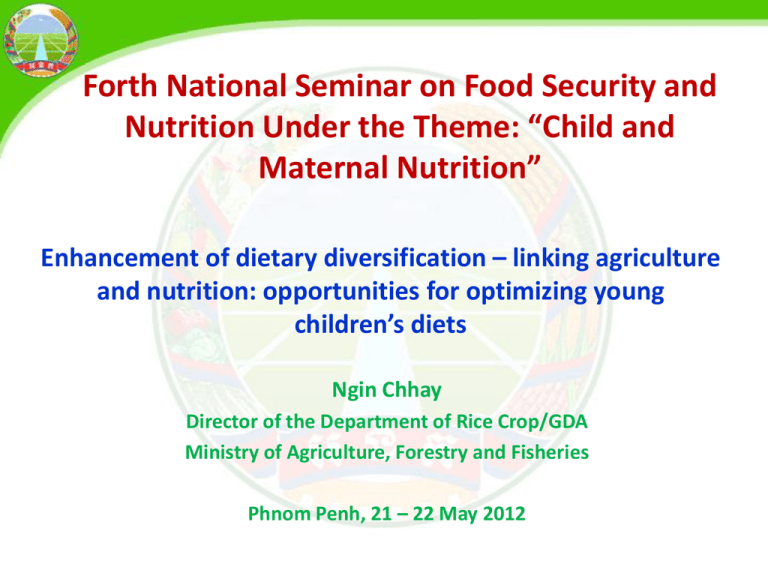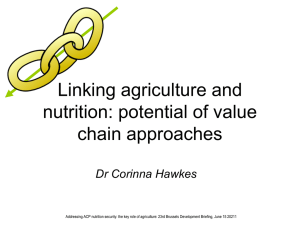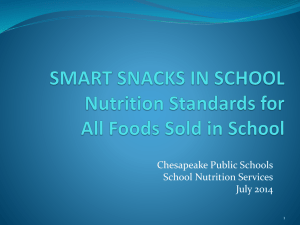English - Food Security and Nutrition
advertisement

Forth National Seminar on Food Security and Nutrition Under the Theme: “Child and Maternal Nutrition” Enhancement of dietary diversification – linking agriculture and nutrition: opportunities for optimizing young children’s diets Ngin Chhay Director of the Department of Rice Crop/GDA Ministry of Agriculture, Forestry and Fisheries Phnom Penh, 21 – 22 May 2012 Content 1. Overview of Agricultural Development 2. Problems and Challenges 3. Roles of Agriculture in Nutrition 4. Diversification of Small Holder Farming 5. Nutrition Education and Awareness Raising 6. Way Forward 1.1 Overview of Agricultural Development (2011) • Agricultural share in GDP is 28.4% • Composition by agriculture sector: (crops: 54%, fisheries: 25%, livestock:15% and forestry: 6%) • Total fisheries production is 608.000 tons (Inland: 445.000 t; Marine: 91.000 t and Aquaculture: 72.000 t) • Total production of cattle is 4.096.801 heads • Total pig production is 2.099.332 heads • Total poultry production is 22.036.755 heads • Subsidiary crop production was 9,273,923 t and industrial crop production was 652,820 t. 1.2 Achievements against NSDP Indicators NSDP Indicator: Agriculture growth (%) Real growth in 2008 & 2009 and projection for 2010-2013 6 Agriculture growth… 5 4 3 5.7 5.4 2 4 1 3.2 3.4 3.2 2011 2012 2013 0 2008 2009 2010 NSDP Target for Rice Production (million Tons) 7.95 8 7.5 7.17 7.28 7.42 7.5 7.6 • Total rice production in 2011: 8.78 million tones • 7 Surplus: - Paddy rice: 4.34 million tones 6.5 2008 2009 2010 2011 Rice Production (million Tons) 2012 2013 - Milled rice: 2.78 million tones 2. Key Problems and challenges 1. Insufficient quantity, quality and diversity of foods 2. Some households can not afford to have better diets due to poverty and food insecurity; 3. Lack of knowledge and understanding of proper diets 4. Limited educational and awareness raising activities on nutrition; 5. Lack of training on food and dietary diversification, nutrition and health education and dietary counseling skills; 3. Roles of Agriculture for Improving Nutrition 1. Three purposes of Agriculture: a) Produce food for consumption b) Generate employment, income and support rural livelihoods c) Safeguard the environment. 2. Nutritional value chain: a) Production: - increased quantity - availability, stability - improved nutritional quality – variety, diversity and safety b) Preservation, storage, and processing – reduce losses in value and in nutritional quality along the chain c) Transportation and marketing d) Consumption – education. 4. Diversification of small holder farming for better nutrition 4. 1 Diversify production of vegetable and fruits with micronutrient rich varieties • Selecting crops based on nutritional content in addition to yields • Community, home and school vegetable and fruit gardens • Nutrition messages through agriculture extension services and farmers field schools • Rice based Integrated farming systems. • Irrigation management and water supply for agriculture 4. 2 Fisheries and aquaculture for promoting animal sourced foods to improve diets and nutrition • Cage or open culture; pond culture and rice fish culture • Training on skill developments in aquaculture techniques, fish seed production for aquaculture and harvest handling and processing. 4. 3 Small/household animal production for animal protein • Production of pigs, poultry, and other small animals • Improvement of animal breeds, feed and forages • Development of community livestock. 4. 4 Small-scale/home based food processing/ preservation techniques • Setting up woman village association and other village groups • Training in food processing and preservation techniques such as fermentation, soaking, pickling , drying to enhance nutritional quality • Training in food handling, hygiene and sanitation • Nutrition education strategies that increase consumption of adequate and diverse diets • Promoting small-scale agro-enterprises linking to markets for income generation 5. Nutrition Education 5.1 Practical cooking demonstration • New food preparation skills to develop the confidence to prepare new dishes with different varieties of foods • Selection of improved recipes with variety of foods • Performing practical cooking demonstration with participation of caregivers • Home visit to provide opportunity to learn how effective the message given to mothers and encourage mothers to continue with improved complementary feeding. 5.2 Diversified and nutritious complementary foods for young children using locally available and or affordable foods • Focusing on giving food to children from 6-24 months • Food must be diversified and appropriately prepared for different ages of children • Amount of food must be appropriate (eg. at 6 months, 7-8 months, 9-11 months, 12-24 months) • Frequency of food to be given to different age categories • Consistency of food (eg. thickness, attractiveness, smell) • Giving nutritious snack (banana, ripe mango, jackfruit, sweet potato etc) • Food hygiene and sanitation is also the focus on complementary feeding 5.3 Use of locally available, seasonally relevant foods • Seasonal food calendar assessment to evaluate food availability • Provide visual and easy message to understand the impression of food available in different times of the year • Identification of period of year that households have difficult in making balance meals 5.4 Use of diverse production as basis for change • Participatory food cooking demonstration practice • Home visit and counselling and peer education • Using BCC materials (nutrition posters, counselling cards, leaflets, etc) • Posters, manual and booklet on improved food recipes for wider dissemination. 6. Way Forward 1. Promote smallholder food production through integrated rice based farming system, community/household vegetable and fruit gardens combined with nutrition education; 2. Strengthen livestock development through improved animal breeds, feeds, and rearing technology, including management and bio-security to increase productivity; 3. Enhance knowledge and skills in aquaculture development, including fish seed production ,cage and pond culture, and rice fish culture, harvest handling and processing. 4. Promote nutrition learning and healthy eating in schools through school vegetable and fruits gardens; 5. Promote the use of locally available and affordable foods for improved maternal and young child nutrition 6. Promote nutritional approach through local food practices and appropriate food preparation for cultural, social and environmental context 7. Enhance local knowledge on the value of local food selection and eating patterns 8. Strengthen collaboration among relevant institutions, especially health and agriculture sectors to provide integrated support to communities and share experiences and best practices to improve “Child and Maternal Nutrition”.








